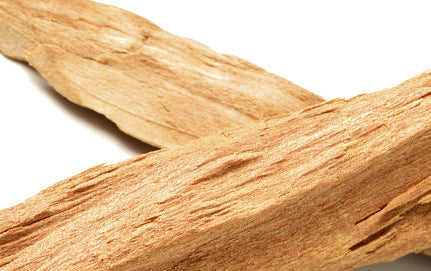A rich, lingering aroma that develops slowly on the skin; acts as a grounding element for lighter notes that may dissipate quickly.
Plant name (Latin): Santalum album L.
Plant family: Santalaceae
Native region: Southern India, Sri Lanka, Indonesia and Timor Leste
Growing habit: Perennial evergreen woody tree
Parts used: heartwood
Essential oil extraction method: Steam distillation of pulverized heartwood
About Indian Sandalwood Oil
Indian sandalwood (Santalum album) is one of the most revered plants known for over two millennia for its medicinal, cosmetic, and religious significance. Main qualities of Indian sandalwood are attributed to the essential oil found only in the heartwood of the tree. This essential oil is comprised of over 125 components; however, its two main sesquiterpene alcohols, namely alpha and beta santalol, render the unique sweet, lactonic woody aroma of Indian sandalwood with multi-faceted benefits.

Why Use Indian Sandalwood Oil
Indian sandalwood has long been identified as the most calming and meditative aroma in medication and yoga. Its mind-calming property while maintaining the attentiveness has been studied and proven scientifically. Indian sandalwood oil has a sweet pleasant base note essential in traditional and modern perfumery. Together with its excellent fixative properties, Indian sandalwood oil provides a perfect base to blend other natural aromatics and increase their longevity on skin. Indian sandalwood oil has also been identified for a number of skin benefits such as protection from pollution and blue light, soothing and increasing skin radiance.
The wood of Indian sandalwood has also been historically used in carvings, rituals and incense in Hindu, Buddhist and Jain religious practices in Indian subcontinent and far east Asia.
How and Where Indian Sandalwood Grows
Indian sandalwood plant is a tropical evergreen perennial woody tree. As a root hemiparasite, a sandalwood tree would depend upon several host trees for nutrition through its lifetime which could span over a hundred years in nature.
Indian sandalwood grows naturally in southern India, Sri Lanka, Nusa Tengarra region of Indonesia and Timor Leste. Although the genus Santalum (Santalaceae family) consists of seventeen different species of trees, only eight are commercially used as sandalwood, among which Indian sandalwood is the flagship species historically known for its aroma, medicinal properties. Indian sandalwood grows in several different climatic and topographical locations based on the availability of host trees.
Australia has pioneered cultivation of Indian sandalwood as a commercial agroforestry crop. Sustainable Indian sandalwood plantations were established over 20 years ago, with now over 5.5 million Indian sandalwood trees growing across 12,000 hectares of land in northern tropical Australia.
Sandalwood Uses and Forms
INDIAN SANDALWOOD ESSENTIAL OIL
In Aromatherapy, Indian sandalwood oil is highly desired for its variety of therapeutic benefits. Studies show that Indian sandalwood oil’s active component (alpha-santalol) calms the body, reacting with different regulatory systems to elicit a physiological response. Ongoing research is uncovering more benefits of sandalwood oil including – reduce anxiety, decrease system arousal, increase alertness and focus, aid learning and memory and improve sleep quality. It is a safe essential oil to be delivered by inhalation and applied on skin directly or diluted with carrier oils or a cream.
INDIAN SANDALWOOD IN FOOD AND BEVARAGES
Indian sandalwood oil has traditionally been used as a flavouring agent in beverages, sweets, mouth fresheners and food smoking. Indian sandalwood has been the base ingredient for flavouring attars of the Indian subcontinent where several spice and floral notes are captured to be used an essence in sweets and savoury dishes. It is considered as an approved flavouring agent and a FEMA-GRAS ingredient. A cordial made with sandalwood is still highly popular in Indian subcontinent as a soothing drink during the summer months.
INDIAN SANDALWOOD IN PERSONAL CARE
Used as a cosmetic ingredient for thousands of years in India, South East Asia and China, Indian sandalwood oil is a multi-functional natural active ingredient with multiple benefits to the skin.
Studies and modern science have demonstrated Indian sandalwood oil’s strong efficacy in skincare supported by its anti-inflammatory, antioxidant, antimicrobial, anti-tyrosinase and anti-MMP properties. With a soothing and pleasant aroma, Indian sandalwood oil is known to reduce signs of aging, brighten skin, reduce the appearance of acene, and protect against blue light and pollution.
A stable and safe ingredient, Indian sandalwood oil can be easily formulated in products like gels, serums, creams and face washes for wide applications in the personal care space.
The Use of Indian Sandalwood Oil in Ayurveda
Earliest records of sandalwood appear in the Ayurveda system of medicine as early as 500 BCE. Charaka Samhita (2nd Century BCE) and consecutive canons of Ayurveda categorise the pharmacology of sandalwood in substances to balance Pitta energy in body. Known as Chandan in Sanskrit, Sandalwood is used both as an external and internal medicine in treating imbalance in Pitta energy, used for detoxifying, improving skin radiance, soothing, cardioprotective and spermatogenic properties.
Several Ayurveda formulations consist only of sandalwood with a carrier base; sandalwood is also commonly used in polyherbal drugs which are formulated as powders, pills, decoctions, syrups, distillates, oils and smoke. Sandalwood is listed in the volume three of the current Ayurveda Pharmacopoeia as Sveta Chandan (White Sandalwood) with a complete monograph. Sandalwood is prescribed in external and internal inflammation, ulcers, blood and genitourinary diseases, skin and eye health, nausea and anxiety.
The Use of Indian Sandalwood Oil in Traditional Chinese Medicine
Sandalwood known as Tan Xiang has been used in traditional Chinese medicine since 500CE. First recorded for its medicinal properties on Mingyi Beilu by the famous pharmacologist Tao Hongjin. Sandalwood is identified as warm acrid substance which acts on the spleen, stomach, heart and lungs. Physiological mechanism of action of sandalwood as per Chinese medicine is by activating Yang energy to move qi and reduce bi, ultimately restoring harmony in body. Indicated primarily for discomfort in the chest and stomach caused by cold, stagnation and obstruction, sandalwood releases obstruction and warms the centre of the body. Monograph for Santalum album (Lignum Santali Albi) is listed in the Pharmacopoeia of the Peoples Republic of China.
Indian Sandalwood in Incense
Indian sandalwood oil is one of key ingredients in traditional incense practices around the world. Indian incenses use powdered sandalwood to make sticks and cone shapes Dhoop, which are used in prayer and cultural events. Charcoal sticks soaked in essential oil blends containing sandalwood oil are popular in the Indian subcontinent for ambient care. Chinese incense culture practiced for over a millennium uses pure wood, powder and sticks, coils and cones of different types. Chinese incenses are an essential part of prayer and auspicious activities, which is practiced in many far eastern cultures. Japanese Kodo tradition is an incense appreciation system where a sandalwood plays a vital role. Bhakoor of Arabian culture is another example of sandalwood used in aroma appreciation and ambient care. Incense blocks or balls made with powder by moulding or wood pieces infused with essence are burned on charcoal burner known as Mubkhara. A common trait for all the traditions is that sandalwood aroma is considered divine and pure and used mainly for meditation and prayer.
The Symbolism of Indian Sandalwood
Indian sandalwood is among the few plants with an immense cultural significance to Asia, particularly the Indian subcontinent. Sandalwood signifies purity and soothing to mind, body, and soul. A paste made by grinding sandalwood with water is applied on idols and on devotee’s forehead in Hindu and Jain rituals. Offering sandalwood to gods is considered as offering health and wealth. The aroma of sandalwood has been legendary and compared with the coolness of moon and known to be the most auspicious aroma. Literature and poetry have numerous references to sandalwood in spiritual as well as romantic context. Chinese culture has a special symbolism for sandalwood alike to divineness with constant reference in literature.
The History of Indian Sandalwood

First written information about sandalwood appears in Yasaka Nirukta a 500BCE Sanskrit literature on Hinduism. Thereafter, Indian sandalwood was mentioned in religious and romantic literature until the present day. By the 300 BCE, Indian sandalwood was recorded as a good to be taxed by the state as recorded on the Arthashashathra , the Indian treatise of economics and administration. Sandalwood was introduced to China during the Tang dynasty, since then it has played an important role in Chinese culture, making it among the most valuable imports to the empire. Medicinal properties of Indian sandalwood appeared in every treatise and Materia Medica in Ayurveda and Traditional Chinese Medicine. Legendary references of sandalwood use by Queen Cleopatra has been mentioned, however, Queen Elizabeth II and Queen Marie Antoinette have reported tohave used sandalwood in perfumery and beauty regime.
As the demand and the value of sandalwood increased Sultan of Mysore Kingdom has declared Sandalwood as the Royal tree in 1796. Widespread poaching of the valuable heartwood in the wild for over decades has led Indian sandalwood to reach extinction and listed on IUCN red list.
The Science of Indian Sandalwood Oil
Indian sandalwood oil is composed of over 125 constituents, from which two main sesquiterpene alcohols alpha and beta santalols make the around 80% of the composition and give the unique sandalwood aroma. Although beta santalol is half the volume component of its alpha isomer, it has a higher odour threshold and produces the warm, woody, sweet and lactonic notes of sandalwood.
While the base characteristics of sandalwood aroma come from the two main components, it is the minor components which give the subtle nuances unique to natural Indian sandalwood. Some of these constituents are synthesised by the tree parallel to santalols, but others are products of processing and distillation. It was identified that human nasal epithelium and skin keratinocytes have a specific odour receptor known as 2AT4, which is triggered by the santalol molecules to trigger the brain to recognise aroma as well as act on human skin and hair follicles.
Indian sandalwood oil has been identified for its remarkable antioxidant and anti-inflammatory properties on skin both in-vitro and clinical studies. Psychopharmacological studies have found that the Indian sandalwood oil is to decouple the brain’s central and autonomic nervous system activities to produce attentiveness while calming the body. There are several in-vitro studies conducted on anticancer and anticholinesterase activities of Indian sandalwood oil, which can benefit the human health immensely.
Chemistry and bioactivities of sandalwood has been extensively studied, yet there are many unknown properties of this mysterious tree to be uncovered.

